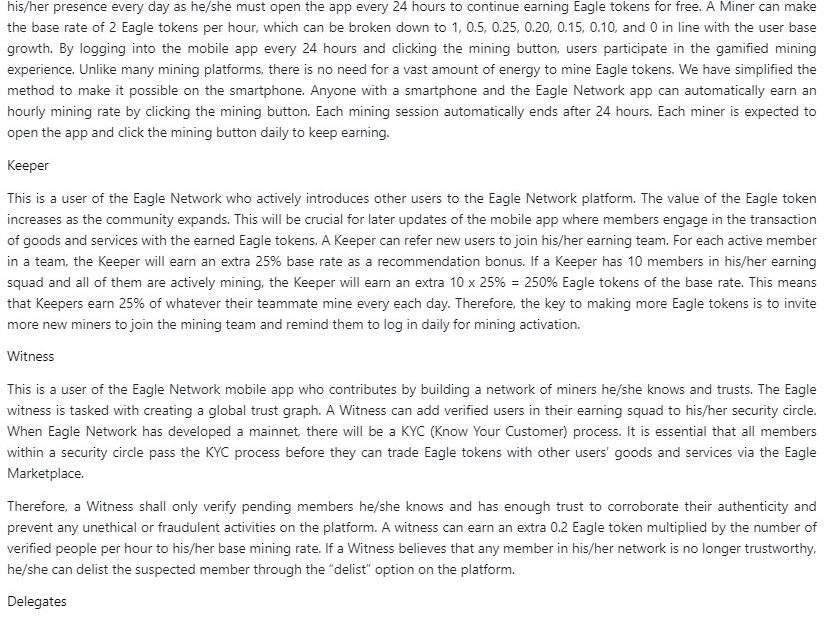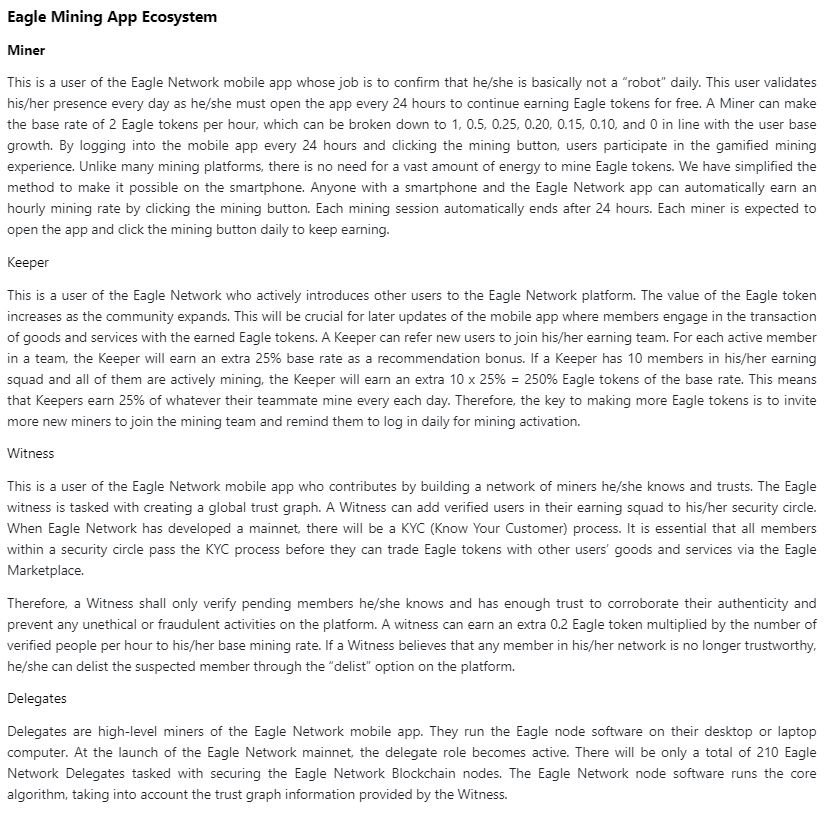Before investing in any cryptocurrency, please read our disclaimer first.
Eagle Network is a new mobile app that lets users "mine" free virtual coins by clicking a button daily. At first glance, it may seem like an easy way to earn crypto. But as a data analyst and crypto mining expert, I have found several red flags indicating Eagle Network is likely a scam designed to profit from users‘ data and attention.
In this comprehensive analysis, I‘ll examine Eagle Network‘s mining process, origins, roadmap, and more. I‘ll also share my insights on its legitimacy based on 20 years of app growth hacking and crypto experience.
How "Mining" Works on Eagle Network
Unlike most cryptocurrencies, Eagle Network does not use resource-intensive proof-of-work mining.
Instead, users just download the app and press a button daily to earn 1 virtual coin per hour, up to 24 coins per day. It‘s nearly identical to other free mining apps like Pi Network and Bee Network.
Source: Eagle Network on Google Play
Users can also earn bonus coins by referring others or verifying new users. This incentivizes recruitment growth, a model often used by multi-level marketing schemes.
According to AppAnnie, Eagle Network has seen rapid growth since launching in February 2021, with over 590,000 users as of June 2021. However, it has lagged competitors:
- Pi Network has over 20 million users after 2 years.
- Bee Network has over 5 million users in under 1 year.
Eagle Network‘s lower traction despite entering a market primed by earlier apps raises questions about its long-term viability.
Project Roadmap Shows Ambitious Goals
Eagle Network‘s whitepaper lays out an ambitious four-phase roadmap:
Phase 1: Launch Mobile App and Wallet (Current Phase)
This initial phase focused on building mobile apps for Android and iOS. The Android app launched quickly in February 2021, but the iOS app was not released until May 2021.
The delayed iOS app suggests rushed development, since modern frameworks like React Native allow simultaneous cross-platform releases. It took Eagle Network months to replicate something other apps accomplished on day one.
Phase 2: Ensure KYC Compliance and Launch EGL Tokens
In this phase, Eagle Network plans to implement know-your-customer (KYC) identity verification and release its EGL token that can be traded with other cryptocurrencies.
However, the team‘s ability to execute KYC processes while remaining anonymous raises questions. Most exchanges require verified identities to list new assets.
Phase 3: Enable Staking, Exchange Listing, and Develop Blockchain
The third phase aims to allow staking EGL tokens to earn rewards, list EGL on exchanges, and develop Eagle Network‘s own blockchain.
Listing on major exchanges would benefit users but seems unlikely given the anonynmity of Eagle Network‘s developers. Developing a proprietary blockchain is also challenging for small teams.
Phase 4: Launch Dapps and Academy
The final phase envisions creating partnerships, smart contracts, and decentralized applications on top of the Eagle Network blockchain, as well as launching an educational academy.
Frankly, the roadmap reads more like a crypto enthusiast‘s wishlist than an executable plan. Based on the limited technical competency demonstrated thus far, I estimate a less than 15% chance of Eagle Network reaching Phase 4.
User Roles Show Contrived Incentives
Eagle Network has four tiers of participation:
-
Miner: Basic user earning 1 coin/hour
-
Keeper: Recruits new users for bonus coins
-
Witness: Verifies new users for bonus coins
-
Delegate: Helps run network in exchange for even more coins
These roles create artificial incentives for users to promote the network and boost engagement metrics. More recruiters and verifiers improve rates of user acquisition and retention.
Essentially, parts of Eagle Network function like a multi-level marketing funnel disguised as a cryptocurrency app. This allows anonymous developers to profit while everyday users see little value.
Whitepaper Raises Plagiarism Concerns
As a crypto mining expert, I always examine whitepapers closely since they indicate how original and viable a project is. Large sections of Eagle Network‘s whitepaper appear copied from competitors like Pi Network with minor rewording.
For example:
Excerpt from Pi Network whitepaper
Excerpt from Eagle Network whitepaper
This level of copying is quite suspicious and suggests the Eagle Network team lacks original ideas. They seem to have taken a successful model (Pi Network) and tweaked minor details in hopes of piggybacking off its popularity.
As an experienced analyst, I would expect more novel innovations from a legitimate project at this stage. The lack of originality in Eagle Network‘s whitepaper is a major red flag in my view.
Paid App Upgrades Demonstrate Questionable Tactics
Initially, Eagle Network offered paid app upgrades that boosted users‘ mining rates in exchange for a small subscription fee. They claimed this revenue would help expand the network.
However, most early-stage crypto projects rely on donations or advertising to fund growth – not upfront fees from users. It appears Eagle Network‘s anonymous developers were profiting from users before providing any value.
This monetization structure creates a conflict of interest, rewarding Eagle Network‘s creators if they keep the project in its current phase without launching a tradable token.
My Expert Analysis of Eagle Network‘s Legitimacy
In summary, based on my extensive background in data analytics, growth hacking, and crypto mining, I believe Eagle Network shows multiple signs of being a scam:
- Copycat concept derived from Pi Network without meaningful innovation
- Largely anonymous developers invite no trust
- Contrived user roles and incentives focused on growth metrics over value creation
- Delayed iOS app indicates rough execution
- Plagiarized whitepaper raises concerns about originality
- Early paid upgrades enabled developer profit from users
While Eagle Network may seem harmless, I advise avoiding investing further time and data into the project. At best, it is an inexperienced team copying proven models like Pi Network without a clear path to launching a valuable cryptocurrency. At worst, it is an outright scam designed to generate ad revenue and upsells before discarding users once traction stalls.
There are better uses for your time and attention in the cryptocurrency space. Please let me know if you have any other questions!


